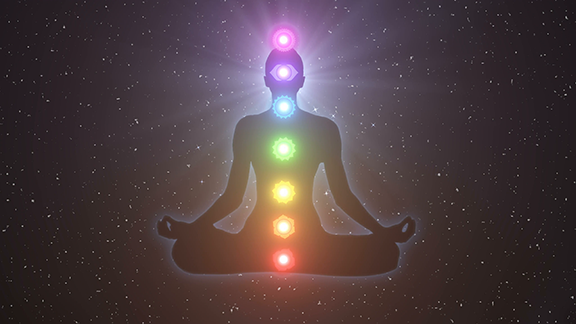 As a yogi, mainly in the Krishnamacharya lineage, and as a practitioner of Buddhist meditation for many years, Chip Hartranft’s work bridges the traditions of Yoga and Buddhism. His deep contemplation and study of the Yoga Sutras is evident in this interview, conducted by Canadian psychotherapist, Yoga teacher and author (the late) Michael Stone, as they discuss the nature of Patanjali’s teachings about kaivalya—spiritual liberation or enlightenment.
As a yogi, mainly in the Krishnamacharya lineage, and as a practitioner of Buddhist meditation for many years, Chip Hartranft’s work bridges the traditions of Yoga and Buddhism. His deep contemplation and study of the Yoga Sutras is evident in this interview, conducted by Canadian psychotherapist, Yoga teacher and author (the late) Michael Stone, as they discuss the nature of Patanjali’s teachings about kaivalya—spiritual liberation or enlightenment.
Michael Stone (MS): What is spiritual liberation according to Patanjali?
Chip Hartranft (CH): For Patanjali, liberation is kaivalya, which means isolation, separateness. That’s the key thing that he is interested in, not philosophical speculation or metaphysics. Remember, the Yoga Sutras is primarily about how a human being comes to know this freedom directly, how he or she comes to abide in it, and Patanjali says that right at the outset, and in the middle and at the end. Yoga is to still the patterning of consciousness. So, one does not attain the freedom of kaivalya—according to Patanjali it’s already the true nature of the conventional self to be an unaware set of processes, fundamentally separate from awareness. And the yogic path settles consciousness to the point where it can reflect that fact, but not to me, myself and I—just to knowing itself!
What Patanjali is trying to name is simply a fact of the world that becomes visible as we awaken: Bare knowing is of a different order than the melodramas of our everyday perception. It appears to be untouched, uncolored by them. It feels omnipresent and enduring, while the perceptual stream is exposed as a succession of brief, impersonal mind-moments, devoid of awareness in and of themselves.
When that happens, according to Patanjali, awareness can just abide in itself and see the way things really are. The world is still there—it looks different but it’s the same world. As to whether it’s an illusion or not, Patanjali is very careful to say that the world’s real. He says, when the world comes in through your consciousness, it’s taking a very different path than the one that comes in through my consciousness—so, two people never see the same thing. But the world’s real. The yogi doesn’t run away from the world to realize this. The yogi becomes completely integrated in the world, and the world’s right there, in every moment. The whole point of dharma-megha-samadhi and cessation is that the yogi is becoming free in things as they are. (Yoga is the path to cessation, as Patanjali defines it in the second sutra—in a sense, everything else in the Yoga Sutras is just commentary.) It’s not that the yogi is abandoning the world, and it’s certainly not the case that the yogi, upon attaining cessation, is dying and becoming reabsorbed into the world as some have claimed.
MS: The way you describe detachment is very physical, embodied, not some kind of otherworldly detachment.
CH: Kaivalya is often translated as liberational freedom, as if it was an achievement of the person, but I don’t think that Patanjali means it that way at all. And he certainly doesn’t mean that the yogi goes off and dies at awakening, as some have suggested! The Yoga Sutras describes a path through a world that is lived-in, offering the yamas and niyamas, for example, to maintain the conventional person’s orientation toward the true purpose of living as he or she navigates through the world of people and objects.
The Yoga Sutras is very much about being present with and seeing through whatever is arising at any given moment, and we’re a dynamic body at each and every moment of our lives. Furthermore, we’re always in the world. In his eight-limbed approach Patanjali addresses all the strata of being that we can experience, whether in relation to the external world of people and objects (yamas) or to personal qualities (niyama) or to the realm of the body in and of itself (asana) or at the level of its energies (pranayama), right on down to the integration of life’s most basic constituents (samadhi). Gross or subtle, whatever you’re doing in this moment is either skillful or unskillful, either an expression of vidya or avidya.
As for kaivalya, the other words that are linked to it in the sublime final statement at the end of the Yoga Sutras—words like sunya (empty) and citti-shakti (power of awareness)—are used to describe the emptiness of knowing. You cannot “thingify” knowing. The mind, the self, is what wants to become enlightened. Why? Because the mind supposes that when it is enlightened it will have power over itself, over objects or perhaps over other people. Our deepest hope is to have power over what seems like the real cause of suffering, which is not getting what we want. That’s why the self wants to become enlightened—the yogic meaning of enlightened self-interest! But it isn’t the self that becomes enlightened, and enlightenment does not gratify “me.”
MS: What is the distinction between me and Purusha?
CH: For Patanjali, Purusha is not “me,” or even an “it.” Purusha is just pure knowing—knowing that witnesses I call “me.” The self, that feeling of “me-ness” is a conditioned set of mental phenomena that are prakritic in nature and their illusion is that they feel like a singular “me” entity positioned behind awareness. The real work is to discriminate between the feeling of self and the knowing of that feeling—Purusha. That is the beginning of viveka, or discrimination.
In practical terms, we begin to notice the not-selfness of one little thing that heretofore had seemed to be self. And so, bit-by-bit, each time we sit to meditate and enter into deeper stillness we begin to intuitively recognize the emptiness of more and more of ourselves and our world. It’s as if the self were a giant edifice that we’re deconstructing brick by brick. Or perhaps better, we’re replacing the bricks one by one with glass tiles so that more and more of a given area is rendered transparent. At enlightenment, the whole edifice is still there, but it’s transparent. Of course, the more bricks we replace with glass, the more we can see that other bricks might also be replaced. So, very gradually, or sometimes abruptly, our object world becomes “viveka-ized,” if you will. It becomes accessible to discrimination, even things that we were really holding onto, such as this sensation is me.
Sensation is the best example because all of this is based on the body. Body sensations are an enormous part of what feels like me. In meditation, this watching as sensations come and go, gaining and then losing seeming urgency is very liberating. That’s the primary strategy leading to cessation: You still the body-mind, which wants to constantly move towards the pleasant and away from the unpleasant, and you will inevitably feel things build up—but then, if you keep watching with vairagya, or the will to not let yourself “get stirred up,” the buildup comes to an end. It’s self-liberating in nature, a very natural process. All of our deeply cherished feelings, the constructs that Patanjali calls pratyaya, all have a short shelf life. As impermanent, conditioned phenomena, our feelings arise when triggered but then pass away by themselves.
MS: Could you speak about the importance of feelings in the process of discernment?
CH: A critical attainment in Yoga is recognizing that a feeling is a feeling. Ordinarily we don’t recognize that a feeling is a feeling—it’s just the way the world seems. When we are depressed, we don’t say, “Sadness has arisen.” We say, “The world is unpleasant, the world is oppressive, onerous, unfair, cruel.” If there’s a bit of awareness, we might come to say, “I am sad.” And then at a certain point we may have a psychological insight, “I’m depressed,” and now there is some recognition that feelings are processes with which we can work a little bit.
The yogic path takes one still farther down this road—we begin to see the conditionality of feelings right in the moment, what the Buddha called their “arising and passing away” in relation to proximate factors. So the beginning of discrimination is detecting the mechanical way that feelings arise. That is to say, when we have a feeling, that’s it’s not just the world in and of itself producing this sense that we have, but rather a reflex in which a conditioned set of mental and physical processes are re-animated by, triggered by reminiscent events. To see that is to arrive at a wonderful new level of clarity.
We have an opportunity to do this each time the shelf life of a construct, or pratyaya, is reached. That’s why there’s no such thing as a wasted meditation: You just sit, watching the body-mind. What you see is that, though we talk about mind, there really is no mind, but rather these impersonal mechanical processes that occur in very predictable ways, one of which is to feel personal.
Is that to say that our life is completely determined? Is there free will? Yes. We can choose to become aware of it. Then the possibilities of freedom are boundless, according to Patanjali. It’s a very optimistic view. Now, perhaps I shouldn’t say optimistic because that implies an unrealistic hopefulness about things, but I do think the Yoga Sutras present a very realistic appraisal of human possibility. Of course, Patanjali says that realizing this possibility requires ardor—you have to make it the central priority of every aspect of your life. And the eight-limbed path crosses every stratum of your life—but he says, if you practice wholeheartedly, enlightenment’s at hand. It’s right next to you.
 Chip Hartranft is the founding director of The Arlington Center, dedicated to the integration of Yoga and dharma practice. He also studies Pali and teaches Buddhist and Yoga philosophy at trainings throughout the US, as well as leading a week-long retreat, The Yoga Of Awakening, every February at Pura Vida in Costa Rica. Chip sits on the board of the Barre Center for Buddhist Studies. He is the author of The Yoga-Sutra of Patanjali: a new translation with commentary (Shambhala). For more information: www.arlingtoncenter.org.
Chip Hartranft is the founding director of The Arlington Center, dedicated to the integration of Yoga and dharma practice. He also studies Pali and teaches Buddhist and Yoga philosophy at trainings throughout the US, as well as leading a week-long retreat, The Yoga Of Awakening, every February at Pura Vida in Costa Rica. Chip sits on the board of the Barre Center for Buddhist Studies. He is the author of The Yoga-Sutra of Patanjali: a new translation with commentary (Shambhala). For more information: www.arlingtoncenter.org.

